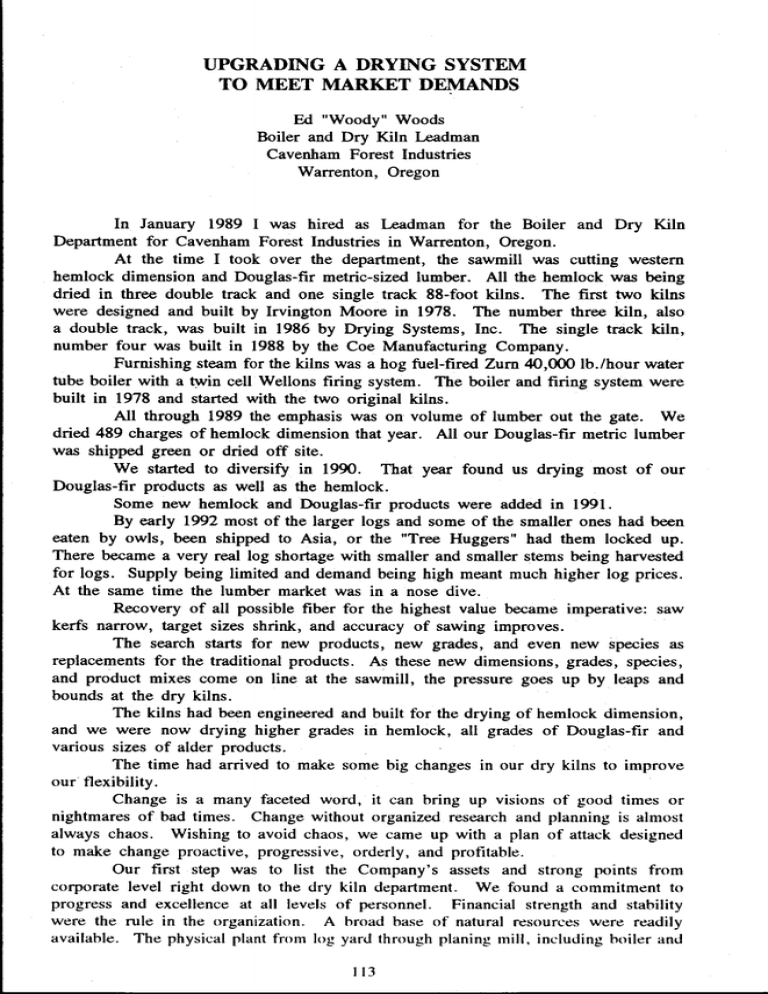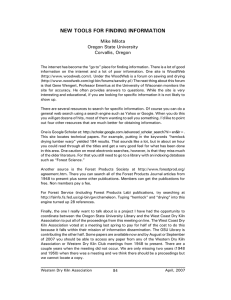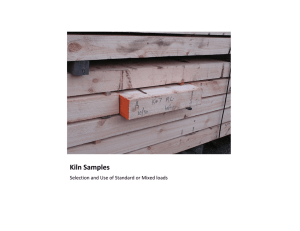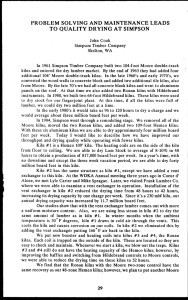UPGRADING A DRYING SYSTEM TO MEET MARKET DEMANDS
advertisement

UPGRADING A DRYING SYSTEM TO MEET MARKET DEMANDS Ed "Woody" Woods Boiler and Dry Kiln Leadman Cavenham Forest Industries Warrenton, Oregon In January 1989 I was hired as Leadman for the Boiler and Dry Kiln Department for Cavenham Forest Industries in Warrenton, Oregon. At the time I took over the department, the sawmill was cutting western hemlock dimension and Douglas-fir metric-sized lumber. All the hemlock was being dried in three double track and one single track 88-foot kilns. The first two kilns were designed and built by Irvington Moore in 1978. The number three kiln, also a double track, was built in 1986 by Drying Systems, Inc. The single track kiln, number four was built in 1988 by the Coe Manufacturing Company. Furnishing steam for the kilns was a hog fuel-fired Zurn 40,000 lb./hour water tube boiler with a twin cell Welions firing system. The boiler and firing system were built in 1978 and started with the two original kilns. All through 1989 the emphasis was on volume of lumber out the gate. We dried 489 charges of hemlock dimension that year. All our Douglas-fir metric lumber was shipped green or dried off site. We started to diversify in 1990. That year found us drying most of our Douglas-fir products as well as the hemlock. Some new hemlock and Douglas-fir products were added in 1991. By early 1992 most of the larger logs and some of the smaller ones had been eaten by owls, been shipped to Asia, or the "Tree Huggers" had them locked up. There became a very real log shortage with smaller and smaller stems being harvested for logs. Supply being limited and demand being high meant much higher log prices. At the same time the lumber market was in a nose dive. Recovery of all possible fiber for the highest value became imperative: saw kerfs narrow, target sizes shrink, and accuracy of sawing improves. The search starts for new products, new grades, and even new species as replacements for the traditional products. As these new dimensions, grades, species, and product mixes come on line at the sawmill, the pressure goes up by leaps and bounds at the dry kilns. The kilns had been engineered and built for the drying of hemlock dimension, and we were now drying higher grades in hemlock, all grades of Douglas-fir and various sizes of alder products. The time had arrived to make some big changes in our dry kilns to improve our flexibility. Change is a many faceted word, it can bring up visions of good times or nightmares of bad times. Change without organized research and planning is almost always chaos. Wishing to avoid chaos, we came up with a plan of attack designed to make change proactive, progressive, orderly, and profitable. Our first step was to list the Company's assets and strong points from corporate level right down to the dry kiln department. We found a commitment to progress and excellence at all levels of personnel. Financial strength and stability were the rule in the organization. A broad base of natural resources were readily available. The physical plant from log yard through planing mill, including boiler and 113 dry kilns was found to be operable and in good repair. Some of the plant was somewhat outdated and narrowly focused. This list of assets gave us our base or foundation upon which we could build. Step number two was to list all the problems and short comings (opportunities). The list of opportunities was then prioritized by cost, need, and value. Like most sawmills our list of opportunities was quite lengthy. Our company had just gone through a corporate change of owners and the mill had a new manager. These two factors helped up to choose our first two projects. We wanted the first projects to be useful, small budget, with fast and sure pay backs. Our first choice project was a covered hog fuel storage area. Keeping the fuel dry during the coastal winter months would be a great step forward in steam production. The number two project we chose was a wet-board drop out, up stream of the planer. This piece of equipment would allow us to drop the wet boards or "sinkers" out of the production line while they were un-planed, full sized and re-dryable. We would also be able to raise the average moisture content of kiln charges to reduce over drying degrade, and shrinkage. The hog fuel storage building project was given to a three-man team to complete. The team chose the location, drew plans, secured bids from various vendors and contractors, wrote up and submitted the capitol funding application to corporate, awarded bids to vendors and contractors, and supervised construction. Each step of this process was subjected to the approval of management. The original fuel storage project showed an eleven-month pay back on paper, the real pay back time was six months. The wet board drop out project went through the same basic procedure. The main difference was that more time was spent looking at various products and vendors. The wet board drop out project penciled in for a ten-month pay back. The actual pay back was eight months. Having established credibility at the corporate level with the two successful projects, we were ready to move on our first large-budget improvement. Project number three on our priority list was variable frequency fan drives and computer controls for the dry kilns. A two-man team consisting of our electronics technician and me, the boiler and dry kiln leadman, was given the task of completing this project. As we were soon to find out there are many manufacturers offering a wide variety of computer controls for dry kilns and nearly as many manufacturers and vendors of variable frequency fan drives. We needed to narrow down the field. Comparing many systems to a list of questions we asked helped us get the number of vendors down to a manageable size. Some of our questions were: a. Would the system serve our present needs? b. Could we expect and get prompt service after the sale? c. How long would the system be adequate for our projected needs? d. Could the system be readily updated and expanded? This process helped us to get the vendor list down to four. At this point we asked for and received quotes on our specified variable frequency fan drives and computer dry kiln controls. Each vendor also supplied a user list of their products and systems. During the next four or five months, I toured vendor's plants, attended demonstrations, met with sales reps., technicians, and programmers. I made many phone calls and mill visits to talk with dry kiln operators who were using the various control systems. All this was done while I kept my department running full speed. 114 By listing and comparing features of each system during this time, a picture began to emerge. The list of four vendors became a list of two. The two systems still in the running were competitive in price and capability to meet our present needs. Both vendors were Oregon-based and each had excellent after the sale service records. Our team again called for demonstrations and presentations of each of the remaining vendor's products and system. Again, we went through our main questions plus many more detailed ones. One of the major differences in the two systems was that one was PLC-based and the other one was based on a micro-processor. Due to the readily available components and replacements, and the ease of repair, programming and re-programming, modifying and expanding, we went with the PLCbased product. Selecting the variable frequency drive units was similar to choosing vendors for the kiln controls, except the main considerations were reliability, of product and service after the sale. We used an outside contractor for installing the conduit for the variable frequency drives and the dry kiln controls. All other work was done in-house. Positioning of components, pulling and connecting all wiring, installing R.T.D.'s plumbing I. to P. panels and water chest lines, etc., were all performed by the electronics or kiln personnel of Cavenham. AT LAST!!! we are ready for start up of the system. We called in the vendor's technicians and got off to a great start on the start up and de-bugging process. On day two of a scheduled five-day start up, a coastal wind and rain storm moved in with very heavy rain and winds gusting to ninety-eight miles per hour. Due to the power outages resulting from the storm, the five-thy start up became the sixday start up. Aside from the weather-related problems, the de-bugging process and start up went well. The dry kiln operators and I are truly impressed with the number of functions the system is able to monitor and control. The kiln operators and I are not computer trained but we have been able to cut drying time by as much as 25% while holding quality and moisture content within tolerance. The system has been operational for about six weeks and we still are not up to speed with the multitude of control combinations built into the system. At the time of this writing we have launched Phase #3 of our boiler and dry kiln updating and improvement. This step will consist of the installation of self cleaning grates and new combustion controls for our Wellons firing system on our boiler. The purpose of Phase #3 is three fold: a. b. c. To better meet new Federal Emission Regulations To produce a much more even steam flow Eliminate another physically taxing and dangerous job. We expect to complete this phase by the end of September 1994. The perfectly dried charge of lumber has never been run, but with the simplification and expansion of monitoring various factors controlling drying, we are getting closer with each passing year. 115



